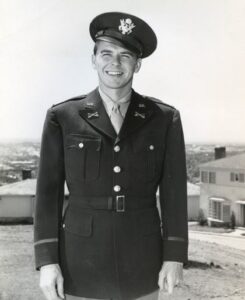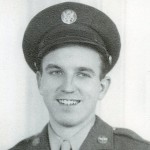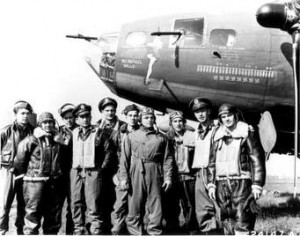memphis belle

 It’s almost unheard of to have a cavalry officer suddenly completely move in a different direction, and become an Army Air Force officer, but on May 15, 1942, Lieutenant Ronald Reagan, who had enlisted in the Army in 1935, was a cavalry officer at the time, applied for reassignment to the Army Air Force. Switching from the Army to the Army Air Force, while not unheard of, was an unusual event, especially in that no one really expected to be in the service for an extended period of time. For the most part, during World War II, it had been agreed upon that the soldier would be returned to the United States by February 1946. That said, it didn’t always make sense to make such a big move as switching branches of service.
It’s almost unheard of to have a cavalry officer suddenly completely move in a different direction, and become an Army Air Force officer, but on May 15, 1942, Lieutenant Ronald Reagan, who had enlisted in the Army in 1935, was a cavalry officer at the time, applied for reassignment to the Army Air Force. Switching from the Army to the Army Air Force, while not unheard of, was an unusual event, especially in that no one really expected to be in the service for an extended period of time. For the most part, during World War II, it had been agreed upon that the soldier would be returned to the United States by February 1946. That said, it didn’t always make sense to make such a big move as switching branches of service.
Then Lieutenant Ronald Reagan was, at least at that time, mostly looking to have a career in acting, and it was here that he would eventually put his thespian background to use making World War II propaganda films. Once his transfer was approved on June 9, 1942, Reagan was given a job as a public relations officer for the First Motion Picture Unit. The First Motion Picture Unit (FMPU) produced military training, morale, and propaganda films to aid the war effort. FMPU released Frank Capra’s “Why We Fight” series and a documentary of the bomber Memphis Belle, the crew of which completed a standard-setting 25 bombing missions in Europe for the first time. No other plane and crew, to that date, had managed to fly the 25 missions and make it back. War was a dangerous lifestyle for the Allied planes. The films were screened on domestic training grounds and in troop camps overseas as well as in movie theaters at home. The Memphis Belle documentary gave people hope that it could be done, and all was not lost.
Reagan did several other films, one of which, “Air Force,” which was later renamed “Beyond the Line of Duty.” That movie told the true story of the heroic feats of aviator Shorty Wheliss and his crew. Reagan narrated the film. While the documentary was originally intended simply to promote investment in war bonds, it won an 
 Academy Award in 1943 for best short subject. Reagan went on to narrate or star in three more shorts for FMPU including “For God and Country,” “Cadet Classification,” and “The Rear Gunner.” Reagan also appeared as Johnny Jones in the 1943 full-length musical film This is the Army. Of course, as we all know, Ronald Reagan’s true destiny was to become one of our greatest presidents of all time and a very brave man.
Academy Award in 1943 for best short subject. Reagan went on to narrate or star in three more shorts for FMPU including “For God and Country,” “Cadet Classification,” and “The Rear Gunner.” Reagan also appeared as Johnny Jones in the 1943 full-length musical film This is the Army. Of course, as we all know, Ronald Reagan’s true destiny was to become one of our greatest presidents of all time and a very brave man.
 In 1990, when the remake of the movie, Memphis Belle came out, I watched it with intrigue, knowing that my Dad, Allen Spencer had been a top turret gunner and flight engineer on a B-17G Bomber in the 8th Air Force stationed in Great Ashfield, Suffolk, England. The Memphis Belle, a Boeing-built B-17F-10-BO, USAAC Serial No. 41-24485, was added to the USAAF inventory on July 15, 1942, and delivered in September 1942 to the 91st Bombardment Group at Dow Field, Bangor, Maine. She deployed to Prestwick, Scotland, on September 30, 1942, moving to a temporary base at RAF Kimbolton on October 1, 1942, and then finally to her permanent base at Bassingbourn, England, on October 14, 1942. Each side of the fuselage bore the unit identification markings of the 324th Bomb Squadron (Heavy). My dad was a part of the 385th Bomb Squadron (Heavy). Dad didn’t arrive in England until early April of 1944. His letter from April 14, 1944 tells his family that he had arrived and couldn’t tell them where he was for security reasons, except to say that he was somewhere in England.
In 1990, when the remake of the movie, Memphis Belle came out, I watched it with intrigue, knowing that my Dad, Allen Spencer had been a top turret gunner and flight engineer on a B-17G Bomber in the 8th Air Force stationed in Great Ashfield, Suffolk, England. The Memphis Belle, a Boeing-built B-17F-10-BO, USAAC Serial No. 41-24485, was added to the USAAF inventory on July 15, 1942, and delivered in September 1942 to the 91st Bombardment Group at Dow Field, Bangor, Maine. She deployed to Prestwick, Scotland, on September 30, 1942, moving to a temporary base at RAF Kimbolton on October 1, 1942, and then finally to her permanent base at Bassingbourn, England, on October 14, 1942. Each side of the fuselage bore the unit identification markings of the 324th Bomb Squadron (Heavy). My dad was a part of the 385th Bomb Squadron (Heavy). Dad didn’t arrive in England until early April of 1944. His letter from April 14, 1944 tells his family that he had arrived and couldn’t tell them where he was for security reasons, except to say that he was somewhere in England.
At the time I watched the remake of the original 1943 documentary film put out by the War Department, I assumed that while the movie said it was based on a true story, there was probably a lot of Hollywood hype to  the movie. So, when I read my dad’s letter to his mother, my grandmother, Anna Schumacher Spencer, I was surprised that my dad mentioned it and said she should go see it. From my experience with the movie, I don’t think it would be a film I’d want to watch while my child was still on active duty and fighting from one of those planes. Both the original version and the remake were real enough to either show or tell of events involving the B-17 Bombers in combat situations, and the inevitable shooting down of the planes by the enemy.
the movie. So, when I read my dad’s letter to his mother, my grandmother, Anna Schumacher Spencer, I was surprised that my dad mentioned it and said she should go see it. From my experience with the movie, I don’t think it would be a film I’d want to watch while my child was still on active duty and fighting from one of those planes. Both the original version and the remake were real enough to either show or tell of events involving the B-17 Bombers in combat situations, and the inevitable shooting down of the planes by the enemy.
Of course, the point was to let people know that The Memphis Belle, a B-17 Bomber had become the first plane to accomplish 25 missions without being shot down. It was designed to be a celebration of that accomplishment. And so it was, but it also proved the stark reality that many other B-17 Bombers had been shot down, and in all reality would continue to be shot down. While the accomplishment of The Memphis Belle is nothing to take lightly, I think it would still be hard to think about all those men lost or imprisoned during that war…especially if I was the mother of an airman. In some ways, it surprised me that my dad would even ask his mom to so see the movie. He was always so protective of her. I suppose that in time, you get used to the events of war, especially when you are in the thick of it day after day, and maybe he thought it would give her hope too.

Nevertheless, it seemed rather strange to me that Dad had talked of this movie with his mother. I know that the Memphis Belle was a star, just because they had made it through without being shot down. They were the first, and to those at home trying to support the war effort, that was a moral booster. That made it important to do the movie and to have the Memphis Belle and her crew do tours back in the states. People needed to see the success of the air war. They needed hope that their loved ones would return. I suppose that was what my dad was thinking when he told his mother that she should go see the movie. I don’t know for sure if she did or didn’t, but in the end my dad came home, and that is all that mattered to my grandmother and to me.

